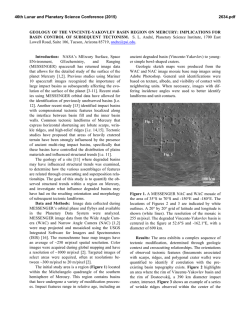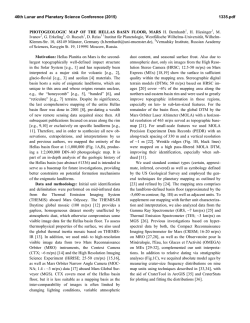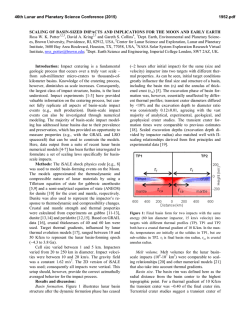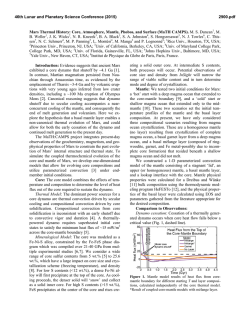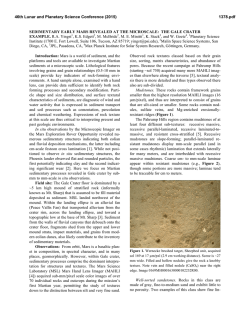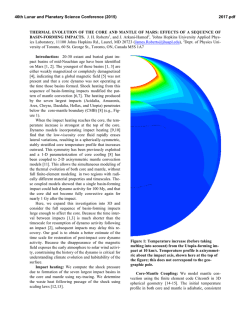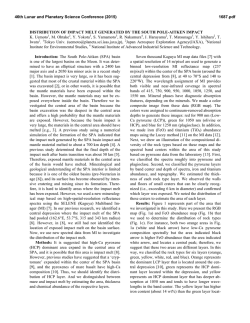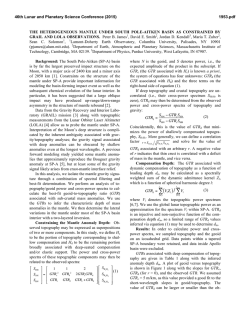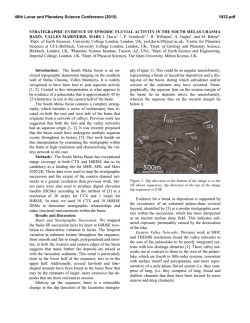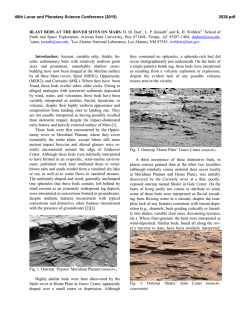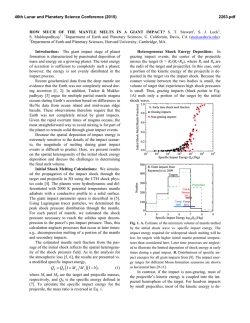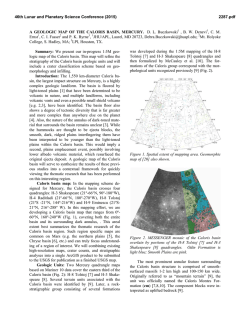
IMPACT BASIN FORMATION ON MARS: FROM BOREALIS TO THE
46th Lunar and Planetary Science Conference (2015) 2212.pdf IMPACT BASIN FORMATION ON MARS: FROM BOREALIS TO THE LATE HEAVY BOMBARDMENT. E. J. Davies1, S. T. Stewart1, R. J. Lillis2. 1Department of Earth and Planetary Sciences, U. California, Davis, CA ([email protected]). 2Space Sciences Laboratory, U. California, Berkeley, CA. Introduction: The Martian crust preserves the imprint of 20 large (>1000 km) impact basins [1] and a global dichotomy that is hypothesized to have formed via a planetary-scale impact event [2]. The impact basin record spans the cessation of the Martian dynamo magnetic field [3], and the youngest impact basins have the cleanest shock-demagnetization signatures [4]. The youngest basins are also the least degraded and have more pronounced crustal thinning within the structure compared to older basins [5]. These observations imply a period of time between the older basins and the 4 youngest impact basins. The length of this interlude is unknown because the impactor flux is uncertain and uncalibrated for early Mars (prior to ~3.9 Gyr ago). The fast formation time of Mars (~44% formed in 2 Myr [6, 7]) and evidence for early crust formation (prior to 4.428±0.035 Ga from meteorite NWA 7533 [8, 9] and 4.21±0.35 Ga at Gale crater [10]) allow for the possibility of a significant difference in the thermal state of the planet between creation of the oldest and youngest impact basins associated with the late heavy bombardment (~3.9 Ga). The crustal dichotomy itself is an ancient feature and the northern lowlands and southern highlands have a similar number density of impact basins [11]. Here, we consider the mechanics of impact basin formation under a range of crustal thickness and thermal gradients on Mars. The final size of an impact basin is sensitive to the thermal gradient [12]. The observed radial extent of crustal thinning and demagnetization can help deconvolve the ambiguities between the impact energy and initial thermal state. This work will help constrain the possible impact energies and impactor sizes that produced the observed basins. For Borealis-scale events, this work improves the initial conditions for subsequent mantle convection and crust formation models. Numerical Method. Basin formation is modeled using the CTH shock physics code [13] with a fixed central gravity field in 2D and self-gravity in 3D. Mars is initialized in gravitational equilibrium with varying thermal profiles. Multiphase model equations of state are used for iron [14], forsterite [15], and silica [16]. The pressure, temperature, and strain-rate dependent rheological model includes a brittle regime for the crust and uppermost mantle [17, 18] and a creep regime for the deeper mantle [19]. The peridotite solidus and olivine liquidus are used to calculate melting [20]. Crater collapse involves a two-phase flow of melt and solid clasts. This complex debris flow is modeled using a simplified approach: when the temperature exceeds the solidus, (i) a pressure-dependent friction law (coefficient of 0.1–0.2 based on melt-lubricated faults [21]) is used at high strain rates (>10-4 s-1) and (ii) a Newtonian fluid rheology is used at low strain rates (when the viscosity of the fluid dominates [22]). Model parameters are constrained by laboratory data. The Borealis Impact Hypothesis: Figure 1 presents an example calculation of the impact hypothesis for formation of a global crustal dichotomy. The impact conditions correspond to the “sweet spot” found in [23] that excavates the outer layers of the planet over an area similar to the northern lowlands without significant disruption of the antipode hemisphere. Previous numerical models of a Borealis-scale impact utilized a Smoothed Particle Hydrodynamics code that did not include the crust or a rock rheology model (purely hydrodynamic) [23, 24]. The dynamics of large impact crater formation are dominated by gravitational forces, so the transient crater size is very similar with and without material strength. However, some important differences arise from the inclusion of a strength model. The global planetary oscillations observed in the hydrodynamic case (10’s to 100’s km in amplitude [24] are absent (or significantly muted) with strength. A similar result was found in the planetary-scale impact study by [25] when strength was included. Heating of the mantle is significantly higher in the impacted hemisphere when strength is included (Figure 1). Heating (from shock and shear deformation) is more localized with strength. The work done by shear deformation during transient crater formation and collapse raises the temperature of the deep mantle in the impacted hemisphere to the solidus; the generation of partial melt reduces the effective strength of the material and localizes heating at late times during the impact event. The amount of melt generated in the impacted hemisphere is significantly higher compared to estimates from hydrodynamic calculations [25]. The example calculation in Figure 1 begins with a cold initial Mars and the sensitivity of melt production on the initial thermal gradient will be presented. Discussion: Our simulations with material strength provide new information about the viability of the impact formation hypothesis for the global crustal dichotomy. Because subsequent crust production in the impacted hemisphere may exceed the crustal thickness of the antipode region, an exogenic-endogenic variation of the impact hypothesis has been proposed [26-29]. In 46th Lunar and Planetary Science Conference (2015) these ‘South Pole Impact’ models, the impact leads to generation of the thicker crust in the southern highlands. Both northern and southern impact models for the dichotomy require specific conditions for the evolution of the dynamo to explain the concentration of highly magnetized crust in the highlands. The initial conditions for the subsequent crust production have assumed a spherical/hemispherical zone of heating or spherical iron core near the surface of the impacted hemisphere. Our calculations show that the zone of heating is not hemispherical when shear deformation and crater collapse are included. In addition, the impactor core is sheared and dispersed around the planet with only a portion lining the impact melt in the collapsed basin. The size distribution of the dispersed core fragments is uncertain. Thus, it is difficult to ascertain how much material may be large enough to descend through the crust and mantle as diapirs and how much may remain mixed into the antipode crust. Scaling Laws for Impact Basin Formation: We will present the relationships between impact energy and final basin size for different initial thermal gradients and crustal thicknesses. We will also consider the sensitivity of the basin scaling law to the material parameters used in the rock rheology model. Using the additional constraints of observed crustal thickness and radius of demagnetization, we shall further constrain the impact energies for the youngest impact basins. 2212.pdf Acknowledgements: This work was supported by NASA grants NNX11AE96G and NNX11AI85G. References: [1] Frey, H. (2008) GRL 35, L13203. [2] Wilhelms, D.E. and S.W. Squyres (1984) Nature 309, 138. [3] Lillis, R.J., et al. (2008) GRL 35, L14203. [4] Acuña, M., et al. (1999) Science 284, 790. [5] Minton, D., et al. (2012) Early Solar System Impact Bombardment II, 4040. [6] Tang, H. and N. Dauphas (2014) EPSL 390, 264. [7] Dauphas, N. and A. Pourmand (2011) Nature 473, 489. [8] Humayun, M., et al. (2013) Nature 503, 513. [9] Bellucci, J., et al. (2015) EPSL 410, 34. [10] Farley, K., et al. (2014) Science 343, 1247166. [11] Frey, H.V., et al. (2002) GRL 29, 1384. [12] Miljković, K., et al. (2013) Science 342, 724. [13] McGlaun, J.M., et al. (1990) Int. J. Impact Eng. 10, 351. [14] Kerley, G.I. (1993), Report SAND93-0027, Sandia National Laboratory. [15] Canup, R.M. (2012) Science 338, 1052. [16] Melosh, H.J. (2007) MAPS 42, 2079. [17] Senft, L.E. and S.T. Stewart (2009) EPSL 287, 471. [18] Zucker, R.V. and S.T. Stewart (2010) LPSC 41, 2722. [19] Kawazoe, T., et al. (2009) PEPI 174, 128. [20] Zhang, J. and C. Herzberg (1994) JGR 99, 17729. [21] Del Gaudio, P., et al. (2009) JGR 114, B06306. [22] Kohlstedt, D.L. (2002) Rev. Min. Geochem. 51, 121. [23] Marinova, M.M., et al. (2008) Nature 453, 1216. [24] Marinova, M.M., et al. (2011) Icarus 211, 960. [25] Leinhardt, Z.M., et al. (2010) ApJ 714, 1789. [26] Reese, C., et al. (2010) JGR 115, E05004. [27] Reese, C., et al. (2011) Icarus 213, 433. [28] Golabek, G.J., et al. (2011) Icarus 215, 346. [29] Leone, G., et al. (2014) GRL 41, 10.1002/2014GL062261. [30] Wieczorek, M.A., et al. (2012) Science 335, 1212. [31] Stewart, S.T. (2011) LPSC 42, 1633. Figure 1. Simulation of a Borealis-scale impact event [similar to Fig. 2D in 23] using the CTH shock physics code with the rock rheology model from [30, 31]. View of the plane through the center of planet with colors denoting material (upper row) and temperature (lower row). Example 3×1029 J event: a 2200 km differentiated projectile (dark grey core and brown mantle) hits Mars (light grey core; grey mantle; blue 60 km thick surface layer of crust) at 6 km/s and 45°. With a rock rheology model, the mantle heating is localized to the impact hemisphere. The entire surface is heated by secondary impacts, including fragments of the core of a differentiated impactor. Note that the calculated temperatures do not include the latent heat of melting (due to incomplete equations of state but it is approximated in the rheology model); partial and complete melt correspond to dark red and black.
© Copyright 2026
